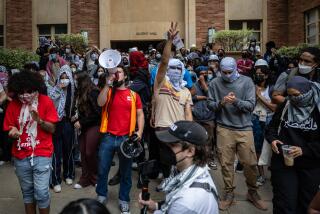Russell Means--25 Years on Warpath Fighting for Indian Causes : Crusader: Through all of his radical activities probing the fabric of American society, he remains a latter-day hero to his people.
- Share via
DENVER — Twenty years ago he led a 71-day occupation at Wounded Knee, S.D., and federal agents hauled him away. He defaced a statue of Christopher Columbus, and the court said it was free speech.
He was charged with murder and exonerated. He joined the Moonies once and he tried running for president twice.
During the past quarter-century, the American Indian’s most visible activist and crusader has been Russell Means.
The takeover of Wounded Knee by 300 members of the American Indian Movement on Feb. 27, 1973, was the Indians’ “finest hour,” Means says.
The armed Indian activists occupied Wounded Knee, site of an Indian massacre by federal troops in 1890, to demand a Senate investigation of the plight of American Indians. The occupation ended with two AIM members killed and two federal agents wounded.
Before the Wounded Knee occupation, Means said in an interview, “There was no advocate for Indian people anywhere in the United States of America. Now, virtually every Indian community are advocates for themselves.”
His dark, chiseled features worn by his 53 years and his many experiences, Means seldom smiles. But his recollections are peppered with laughter as he describes the odd turns his life has taken.
“I’ve always been in defense of being an Indian,” he says.
One of his earliest memories is going to the first-grade in Huron, S.D., in 1945 and being taunted by a younger boy--blond-haired and fair-skinned.
“He called me a nigger,” Means says. “I didn’t know what ‘nigger’ meant--so I liked the term.”
But then he told his grandmother about the incident, and she set him straight. He was being disparaged, not praised.
That first exposure to racism helped shape his view of the world.
“My ultimate aim is the reinstitution of pride and self-dignity of the Indian in America,” Means says.
His first aspiration was to be a high school history teacher, but he changed his mind and became an accountant, wanting “to be rich.” He took a job in 1967 with a government-funded Indian relocation experiment in Cleveland.
Two years later, he discovered AIM. Its members were “very well-prepared and came with expertise,” he recalls.
Means soon became an activist in his own right. He and several other Indian activists disrupted Cleveland’s 175th anniversary celebration, and he participated in a weeklong takeover of the Bureau of Indian Affairs in Washington, the very entity that had given him the job in Cleveland.
Since then, Means has lived the life of an Oglala Lakota militant activist, and he looks the part, dressed in denim, wearing Indian jewelry and his long black braids wrapped in leather-studded braid covers.
Just ask Hollywood.
Means played a key supporting role in the movie “The Last of the Mohicans,” depicting the stoic Mohican elder Chingagchook. He is pleased that he has been accepted by a medium that he thought would be forever closed to him.
“It’s a tremendous voice, a tremendous tool,” he says.
Means wants to produce a movie to educate the American people about Indians and is discussing the project with several production studios.
“I’ve become more optimistic,” he says. “The doors are opening. I’m going to create . . . it’s a movement of our ancestors.”
It’s more of a mainstream approach than what he has employed in the past.
Besides crossing swords with the authorities over the Wounded Knee occupation, Means got into trouble over a barroom shooting death in Scenic, S.D., but was cleared of charges of aiding and abetting.
Two years ago, he was arrested for pouring a red liquid on the Columbus statue in downtown Denver, but the charges were later dropped after it was determined he was exercising his First Amendment rights.
Last Oct. 10, Means scored, in his view, one of his biggest victories--stopping Denver’s Columbus Day parade. The Italian-American Federation, the parade organizer, canceled at the last minute because it feared clashes with hundreds of Indian activists and their supporters massed in a nearby park. In the days leading up to the parade, Means’ legal efforts to block the parade were rejected.
“I am extremely elated that the federation has chosen the moral high ground. All the politicians and judges can go to hell,” a tearful Means said after the parade was canceled.
He also has urinated on Mt. Rushmore and poured red paint on Plymouth Rock.
Means once tried to “arrest” a BIA official and has led numerous sit-ins at county courthouses. He was a major voice in last fall’s protest of the use of Indian names for sports teams.
Means spends much of his time on the road, but has a home on the Pine Ridge Reservation. He also has been married four times and has 10 children and 17 grandchildren.
While Means has developed contacts across the nation in his quest to free the Indian people from government stewardship, he is unwilling to make alliances with high-profile politicians.
“You can’t work with the enemy,” he says. “I’ve been everywhere in the Eurocentric society trying to find allies. I didn’t find any.”
His search briefly made him a disciple of the Rev. Sun Myung Moon in the mid-1980s, but he didn’t find what he was looking for there.
He flirted briefly with politics, campaigning as a running mate to Hustler magazine publisher Larry Flynt in 1983. That political foray ended after four weeks when Flynt appeared in a courtroom wearing a diaper made from an American flag.
Four years later, he ran unsuccessfully for the Libertarian Party’s presidential nomination, to “enhance and validate the Indian primitive way of life.”
These days he steers clear of conventional politics, and says he was not encouraged either by the election of President Clinton or Colorado Sen. Ben Nighthorse Campbell, who is half Northern Cheyenne.
“Campbell further ingratiates the government’s seduction of the Indian people,” Means says.
Means says Indians face continued dependency on the government and high alcoholism and infant mortality rates. He recently spent time in Canada helping the Indian tribes there move away from government dependency.
“If it doesn’t happen here, it will happen in Canada,” Means says.
His radical methods have earned Means both admiration and criticism from fellow Indians.
Tom Giago, publisher of the Lakota Times in Rapid City, S.D., says Means could do more for Indians if he would shift away from the radicalism that guided him in the 1960s and 1970s.
But Tom Poor Bear, who lives on the Pine Ridge Reservation and traveled with Means in the 1970s, says, “He’s one of the voices who gave hope to the people.
“There are many ways to look at Means, from movie star to activist--he’s a people’s man.”
More to Read
Sign up for Essential California
The most important California stories and recommendations in your inbox every morning.
You may occasionally receive promotional content from the Los Angeles Times.










